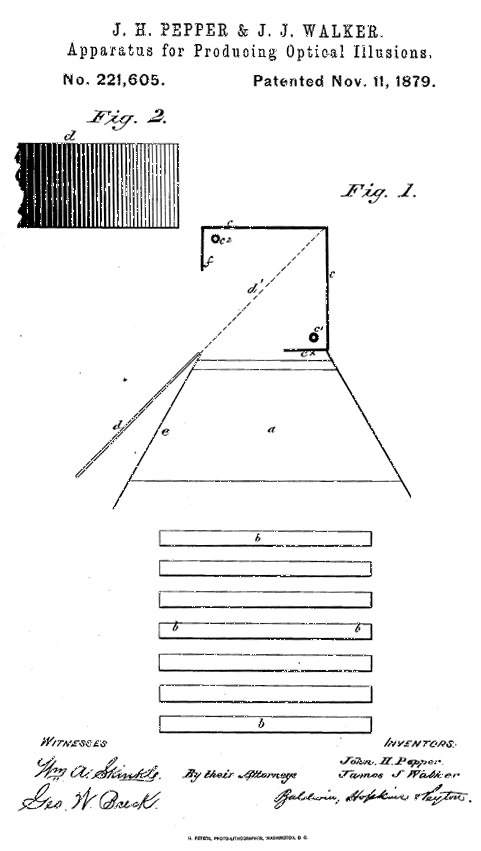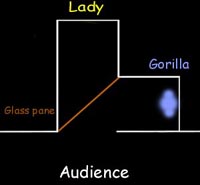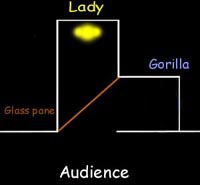Pepper's Ghost
By: Rick Davis
Of the many special effects used in haunted houses, darkrides, and carnival sideshows today, one of the most amazing and baffling illusions is also one of the oldest. "Pepper's Ghost" has been seen by millions of people since its introduction in the 1860's. "Pepper's ghost" is a very simple illusion with a startling effect that allows live people or objects to slowly materialize into a scene.
"Dircks' Ghost"
While John Henry Pepper is generally given the credit for inventing this illusion, perhaps what is known today as "Pepper's Ghost" should have rightly been called "Dirck's Ghost".English engineer Henry Dircks' had created a small working model of the effect around 1860. The design wasn't practical for a full size stage illusion, though.
"Professor" John Pepper heard about this optical principle and thought he had the solution to Dircks' problem. The two men soon became partners and began collaborating to create the effect as stage illusion. They did indeed succeed in finding a workable solution and applied for a patent together.
Simply put, they used a large plate glass pane, set at a 45 degree angle either vertically or horizontally, that reflected brightly lit objects off stage, superimposing them with the on stage set and actors. This illustration shows one early variation from the perspective of the stage.
In this case the "ghost" is an actor located forward of and below the stage floor. The glass pane illustrates the reflection of the off stage "ghost" while the leftmost "ghost" simulates what the audience thinks they see.
Later versions of the invention included a lens to improve on the image. Another of the later patents included a variation that had a large sheet of glass that was clear on one end and mirrored on the other. It was designed to gradually "fade" from transparent to reflective. Made in this fashion, objects could fade in or out of the scene without adjusting the intensity of the spot light, or they could morph from one thing into something else by sliding the glass side to side, an effect not easily done in an era long before electronics.

The effect's debut was in a show at the London Polytechnic Institution, where Pepper was a professor. Pepper's first presentation was entitled "The Knight Watching His Armor". Unfortunately, Dircks and Pepper parted company soon after. Without Pepper, it was unlikely that Dircks would have had the skill and showmanship required to have taken the idea beyond the concept stage and onto the stage himself.
A Ghost Story
A "true" Australian ghost story about man named Fredrick Fisher who disappeared in 1826 is said to have inspired Professor Pepper to take his stage illusion to Australia. The story goes that Fisher, a paroled convict, facing imprisonment again, signed over his property to George Worrell.After six months in prison, Fisher returned home to find Worrell claiming the farm was his. Then Fisher disappeared.
Suspicion was aroused when Worrell began wearing Fisher's clothing and showing an obviously forged receipt for his horse.
A man named James Farley was walking on the property one night, when he came across an apparition sitting on a fence pointing a bony finger in the direction of the creek. After a search of the area, Fisher's body was found.
The men in the story where real but of course the reality of the ghostly apparition was in question. At the time this story was well known and as such was a natural choice for Pepper to use in presenting his illusion in Australia.
Other stage productions quickly adopted its use for presentations such as Dickens's A Christmas Carol and Shakespeare's MacBeth and Hamlet. While the apparatus allowed live actors to interact with ghosts or other transparent objects, the illusion had limited applications for the stage and presented some very real problems that further limited its use. The extremely large plate glass pane that was required was both difficult to place into position as well as dangerous to handle. A more important problem was the fact that the glass effectively acted as an acoustic shield between the performer and the audience, a great problem in an era decades away from microphones and amplifiers.
Common Examples of "Pepper's Ghost"
 If you have ever looked out your window and seen what appeared to be your lamp and objects near it seemingly floating in your yard, then you have experienced "Pepper's Ghost", or more correctly "Dircks' Ghost" as this effect is more similar to Dircks' original idea.
If you have ever looked out your window and seen what appeared to be your lamp and objects near it seemingly floating in your yard, then you have experienced "Pepper's Ghost", or more correctly "Dircks' Ghost" as this effect is more similar to Dircks' original idea.
The classic carnival sideshow "Girl To Gorilla" in which a beautiful young lady morphs into a ferocious gorilla, is a great example of Pepper's original idea. Disney's classic Haunted Mansion scenes where ghostly images appear to swirl across a ballroom and the ghost riders that appear to be sitting next to you in your ride car are darkride uses of the effect. MGM/Disney also uses the effect in Twilight Zone - Tower Of Terror while Paramount's King's Island also has a large scene using the illusion in Phantom Theater.
Other uses of this optical principle include the HUD, or Heads Up Display that has been used for decades in fighter aircraft and is currently being incorporated into high-end automobiles.The devices "project" an image of the instrument into the field of view of the pilot or driver causing the instruments to seeming hover in front of the vehicle.
Some lesser known uses of the principle include two instruments, the Reflex Metrograph and the Reflex Microscope used in the fields of science and dentistry.
How do they do that?
In Disney's Haunted Mansion and PKI's Phantom Theater, Pepper/Dirck's method is used to cast ghostly images onto the ballroom and theater, respectively, by using figures located above or below the ride vehicles track.
The scene in the Haunted Mansion where hitchhiking ghosts join you for a ride in your car uses a slight twist on the illusion. In this case a half-silvered sheet of glass (two-way mirror) is between you and the ghost, which is in front a black background. The ghost is illuminated by a spotlight and is mounted on a track synchronized to move at the same speed as your ride car. In this case you are seeing the actual image of the "ghost" but your image is the reflection. The effect is a ghost riding along with you in your "Doombuggy".
In the "Girl to Gorilla" illusion, a young lady stands behind a large plate glass sheet which is set at a 45 degree angle to the audience. When the illusion starts she is brightly illuminated making her visible to the audience.
Unseen by the audience is a small room in front of and to the left or right of the girl and hidden from the audience. This room is not lit at first.
In this room waits the "gorilla" that stands before the same color background as the girl. Both the girl and the gorilla are precisely positioned for the illusion to work.
Slowly and imperceptibly, the lighting on the girl decreases at the same rate that the light on the gorilla increases. Done properly, the background illumination seems to remain unchanged. To the audience, however, the girl seems to slowly transform into the gorilla.
 In reality, the girl is no longer illuminated but the gorilla is, its image reflected in the glass. Of course the gorilla rattles the cage door and bursts out of its cage and into the audience chasing most customers out, making way for a new group.
In reality, the girl is no longer illuminated but the gorilla is, its image reflected in the glass. Of course the gorilla rattles the cage door and bursts out of its cage and into the audience chasing most customers out, making way for a new group.
A similar haunted house illusion is performed by replacing the gorilla with a skeleton for a different scary effect.
Would you like to create a simple Pepper's Ghost illusion for Halloween? Big Scream TV™offers DVDs that not only show you how to create a neat Pepper's Ghost illusion for you home (and for commercial use with their permission) but also offers you a choice of three different "shows".
Watch for future "How did they do it?" articles about darkride and funhouse gags and illusions.
This article ©2001 Rick Davis and used with permission.
Photos ©2001 Rick Davis, and used with permission.




